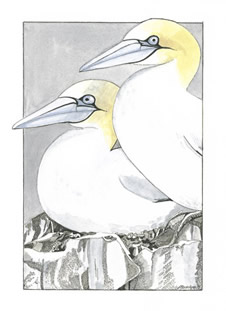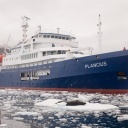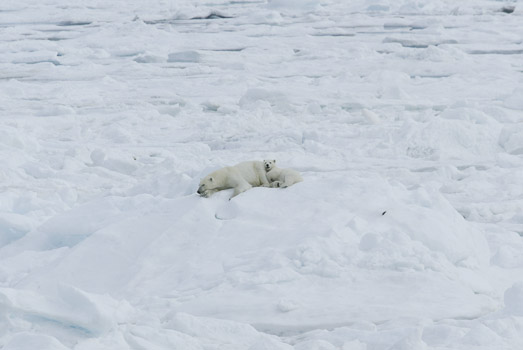CONSERVATION IN FOCUS (1):
SCOTLAND’S SHETLAND ISLANDS TO
ARCTIC NORWAY’S JAN MAYEN AND
THE SVALBARD ARCHIPELAGO
June 7-21, 2013 (15 Days/14 Nights  ) )
Audrey Benedict, Dr. Geoff Hammerson,
Wendy Shattil & Bob Rozinski,
Marilyn Hailbronner and Sarah Drummond
The islands of the North Atlantic and the High Arctic are legendary for their rugged beauty, dramatic geology, wave-pummeled sea cliffs, the splendid cacophony of thousands of nesting seabirds, wildflower-dotted heaths and tundra, and cultural traditions dating back to the first Viking explorers. This special voyage, aboard Oceanwide Expedition’s superbly comfortable 114-passenger M/V Plancius, takes us from Aberdeen, Scotland to the Shetland Islands of Fair Isle and Mousa, and then to the Norwegian Arctic islands of Jan Mayen, situated 300 nautical miles north-east of Iceland, and the Svalbard Archipelago, located just 600 miles from the North Pole. Our ice-strengthened ship was originally built as an oceanographic research vessel for the Royal Dutch Navy and flies the Dutch flag. She has been completely refitted as a passenger vessel for educational travel in both Arctic and Antarctic waters. Zodiac landing crafts enable shore expeditions and wildlife viewing in areas that would otherwise be inaccessible. Our talented Oceanwide Expedition’s staff includes experts in seabird and sea mammal biology, island geology, and maritime history. Visits ashore and sea-travel days will be enriched by lectures aboard and by our great team of Cloud Ridge leaders. Our focus will be on the wildlife species associated with the North Atlantic oceanic realm and these remote islands—the vast seabird breeding colonies, the whales and multiple species of seals to be seen throughout the voyage, and to observe walrus and polar bear in the Svalbard Archipelago.
 We begin with a visit to the wildlife rich waters of Scotland’s Firth of Forth, where we’ll have our first introduction to seabird biology at the award-winning Scottish Seabird Centre. June marks the peak of seabird nesting activity and the cliffs and sea stacks will be alive with puffins, razorbills guillemots, kittiwakes, fulmars, gulls, and shags—a treat for all the senses! We’ll take a boat trip to the Isle of May National Nature Reserve, traveling first to Craigleith Cliff, site of the SOS Puffin Project, and then to famous Bass Rock, home to 150,000 pairs of nesting gannets. Landing at the Isle of May, we’ll spend several hours onshore observing and photographing the spectacle of a quarter of a million seabirds, including thousands of Atlantic puffins at their cliffside burrows, as well as common eiders, their clutches snug in fluffy nests of “eider down.” We begin with a visit to the wildlife rich waters of Scotland’s Firth of Forth, where we’ll have our first introduction to seabird biology at the award-winning Scottish Seabird Centre. June marks the peak of seabird nesting activity and the cliffs and sea stacks will be alive with puffins, razorbills guillemots, kittiwakes, fulmars, gulls, and shags—a treat for all the senses! We’ll take a boat trip to the Isle of May National Nature Reserve, traveling first to Craigleith Cliff, site of the SOS Puffin Project, and then to famous Bass Rock, home to 150,000 pairs of nesting gannets. Landing at the Isle of May, we’ll spend several hours onshore observing and photographing the spectacle of a quarter of a million seabirds, including thousands of Atlantic puffins at their cliffside burrows, as well as common eiders, their clutches snug in fluffy nests of “eider down.”
Fresh from our adventure in the Firth of Forth, we’ll board the M/V Plancius at Aberdeen, known as the Granite City and many times a winner of the Britain in Bloom competition. Once we are underway in the North Sea, we’ll be able to spot the lighthouse at Girdle Ness,  one of the most iconic of the 97 Scottish lighthouses designed by the “Lighthouse Stevensons,” the famous family of novelist Robert Lewis Stevenson. Traveling northward, we’ll drop anchor first at beautiful Fair Isle, in the Shetlands, the most remote of Britain’s inhabited islands. Fair Isle is also well known for its distinctive knitwear and we’ll be welcomed for tea at the knitter’s co-op. We’ll hike to the Fair Isle Bird Observatory, an important seabird research center and a critical migratory bird monitoring site. Fair Isle is home to 18 species and roughly 250,000 pairs of nesting seabirds! Our timing should be perfect for observing and photographing the nesting activities of Atlantic puffins, Arctic skuas, black guillemots, northern gannets, fulmars, razorbills, and several other species. Our Zodiac trips should also be excellent for spotting near-shore sea mammals such as sea otter, grey seal, harbor porpoise, and both bottle-nosed and white-beaked dolphin—all common species in Scottish waters. From Fair Isle, we’ll continue to the tiny island of Mousa, where we’ll visit a 2,000-year-old Iron Age circular stone tower, a broch, considered one of the best-preserved prehistoric buildings in all Europe. If sea conditions permit, we’ll return to the broch at night to witness the spectacular phenomenon of nearly 6,000 breeding pairs of storm petrels returning to their burrows from foraging trips at sea. one of the most iconic of the 97 Scottish lighthouses designed by the “Lighthouse Stevensons,” the famous family of novelist Robert Lewis Stevenson. Traveling northward, we’ll drop anchor first at beautiful Fair Isle, in the Shetlands, the most remote of Britain’s inhabited islands. Fair Isle is also well known for its distinctive knitwear and we’ll be welcomed for tea at the knitter’s co-op. We’ll hike to the Fair Isle Bird Observatory, an important seabird research center and a critical migratory bird monitoring site. Fair Isle is home to 18 species and roughly 250,000 pairs of nesting seabirds! Our timing should be perfect for observing and photographing the nesting activities of Atlantic puffins, Arctic skuas, black guillemots, northern gannets, fulmars, razorbills, and several other species. Our Zodiac trips should also be excellent for spotting near-shore sea mammals such as sea otter, grey seal, harbor porpoise, and both bottle-nosed and white-beaked dolphin—all common species in Scottish waters. From Fair Isle, we’ll continue to the tiny island of Mousa, where we’ll visit a 2,000-year-old Iron Age circular stone tower, a broch, considered one of the best-preserved prehistoric buildings in all Europe. If sea conditions permit, we’ll return to the broch at night to witness the spectacular phenomenon of nearly 6,000 breeding pairs of storm petrels returning to their burrows from foraging trips at sea.
We’ll spend two days at sea as we make our way to Jan Mayen, a small and extremely isolated Norwegian island situated in the Norwegian- Greenland Sea. This island outpost marks the only exposed portion of the Mid-Atlantic Ridge north of Iceland. From the deck, we’ll be watching for whales, including both blue and fin whales, the two largest whale species in the world, and the more common Minke and orca. Rarely visited because of its remoteness, Jan Mayen is a volcanic island of breathtaking beauty, dominated by the Beerenberg volcano, a dramatically tall snow-capped massif that last erupted in 1984. Glaciers cascade down the volcano’s slopes to the sea and the island’s cliffs are wonderfully alive with the comings and goings of thousands of little auks (or dovekies), Brünnich’s guillemots, and glaucous gulls. If weather and sea conditions permit a landing, we’ll hike across Jan Mayen to Kvalrossbukta to look at the remains of a 17th century Dutch whaling station, photograph tundra wildflowers at peak bloom, and visit a raucous colony of northern fulmar.

Bathed in the glow of the midnight sun, we will sail along the sea-ice edge, keeping watch for several species of whales, dolphins, seals, and pelagic seabirds— until the position of the sea ice forces us to chart a course towards North Spitsbergen. The Svalbard Archipelago lies just 600 miles south of the North Pole and is one of the High Arctic’s richest wildlife sanctuaries. The abundance of wildlife—polar bears, arctic foxes, walrus, reindeer, three species of seals (bearded, ringed, and harp seals), and spectacular colonies of seabirds—is due primarily to warm currents carried north by a branch of the Atlantic’s mighty Gulf Stream. As the frozen sea breaks up, many thousands of cliff-nesting seabirds—thick-billed murres, Atlantic puffins, both Brünnich’s and black guillemots, ivory gulls, black-legged kittiwakes, and little auks—add their voices to a splendid cacophony as they fly between their nests and productive fishing grounds at sea. In addition to these seabirds, we should also see great rafts of common eiders, famed for their soft, superbly insulating feathers (eider down), which they pluck from their breasts to make their nests. Depending on sea-ice conditions, we’ll sail into Raudfjord or one of the fjords in northwestern Spitsbergen, where we hope to spot polar bears at the heads of the fjords, and where bearded or ringed seals may be hauled out on the ice.We’ll also be searching for walrus at their traditional haul-outs at Sarstangen, Engelskmansbukta or at Poole-Pynten. On our last evening in Svalbard, at Alkhornet, we’ll hope to see Arctic foxes hunting and reindeer grazing amidst a wildflower-dotted tundra ablaze in amber twilight—a parting gift from the Land of the Midnight Sun.
Trip Price: Trip and cabin category prices as listed are all-inclusive and include both landbased touring and cruise-related expenses (unless otherwise noted). Trip cost is quoted per person based on double occupancy and the type of shipboard accommodation you requested. The number listed before the cabin category refers to the number of cabins we’ve reserved in that category. Cabins are booked on a first-come, first-serve basis. All cabins have only lower berths and all have windows instead of portholes. Early booking is encouraged to secure your preferred cabin type. Single travelers who wish to share a cabin will be accommodated provided that a suitable cabinmate is available. Those preferring not to share will be charged a single supplement equal to the double occupancy rate for the category chosen.
Trip Price & Cabin Category:
- 2 Superior Cabins (queen-size bed, window,
and private facilities/shower): $6,950.
- 2 Twin Deluxe Cabins (twin single beds,
window, and private facilities/shower): $6,650.
- 3 Twin Window Cabins (smaller cabin than
Twin Deluxe, includes twin single beds,
window, and private facilities/shower): $6,250.
Deposit: $1000. (nonrefundable deposit required
to reserve space, payable by check to Cloud
Ridge, and included in the price quoted above).
Group Size: 14 Trip Rating: 2-3
Traveler’s Note:  indicates a two-day time indicates a two-day time
allowance for international/overnight flights.
Price Includes: Hotels and all meals in Edinburgh and Aberdeen, Scotland and Oslo, Norway, guided trip from Edinburgh to the Scottish Seabird Centre and our boat trip to the Isle of May, mini-coach transport between Edinburgh and Aberdeen, all transfers and baggage handling in Aberdeen between our hotel and the ship, all accommodations (according to the category chosen) and all meals aboard the ship, all shore excursions by Zodiac, a predeparture trip packet from Oceanwide, onboard lecture program, and all services of OE expedition leaders/naturalists and Cloud Ridge naturalists.
Not included: Trip cancellation/interruption insurance and medical emergency evacuation coverage (required by Oceanwide). Roundtrip air travel between your home airport and Edinburgh, Scotland and your return flight from Oslo, Norway. Oceanwide will also book and invoice you separately for our one-way postcruise flight from Longyearbyen (Spitsbergen) to Oslo, Norway. Trip cost also does not include alcoholic beverages sold on board the Plancius, internet access charges, shipboard laundry services, or other personal items.
Need more information about Oceanwide Expeditions or the M/V Plancius? Please visit: www.oceanwide-expeditions.com |
